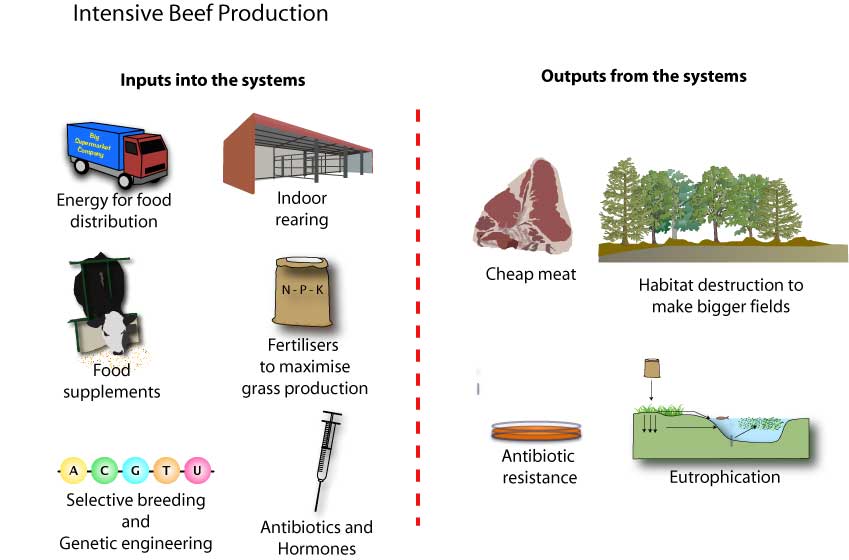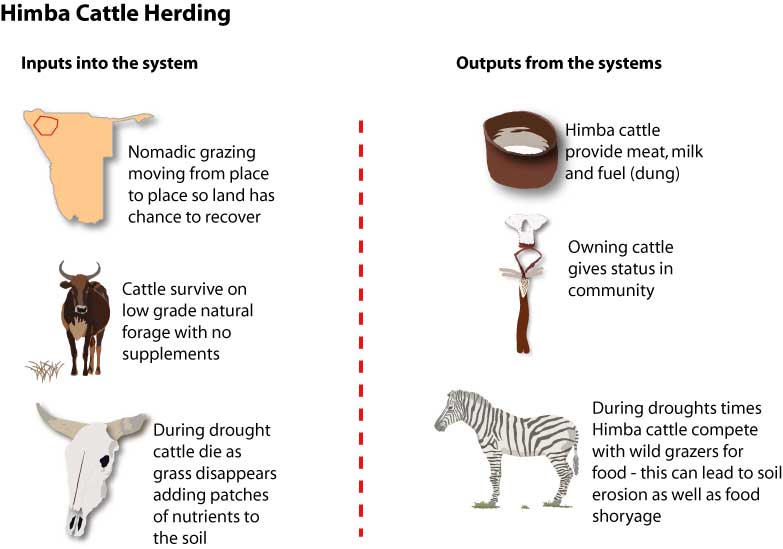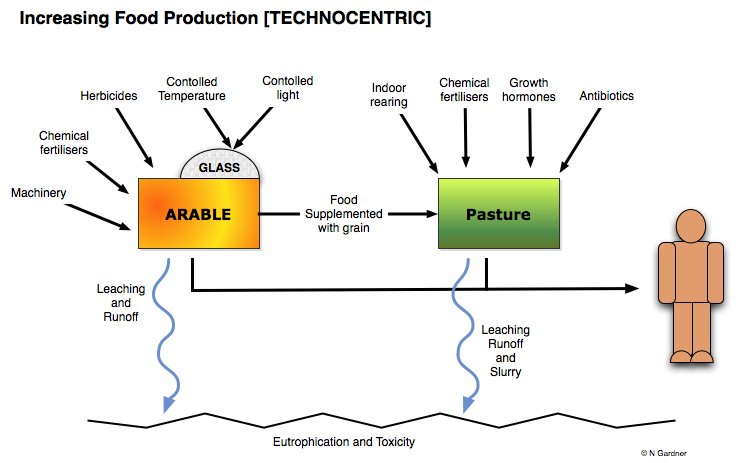3.5. 3: Impacts of Farming Systems
All agriculture regardless of where it is in the world exerts a set of impacts upon the environment. These impacts result from inputs of energy and materials into the system, processes within the system as well as outputs from the system.
The diagram left illustrates some of the impacts of the more common forms of intensive farming found in the developed world.
Intensive beef production:
The diagram below opens a summary of one of these systems in more detail, intensive Charolais beef production in France.
 Charolais are one of the beef breeds of choice across most of Western Europe. Through selective breeding and even genetic engineering bloodlines exist that put weight on quickly but have a low fat cover - preferred by customers. Many Charolais never see grass being fed entirely in doors under controlled conditions eating food high protein supplements and being treated with antibiotics to make sure they stay health. Lots of energy is used transporting and processing the finished meat.
Charolais are one of the beef breeds of choice across most of Western Europe. Through selective breeding and even genetic engineering bloodlines exist that put weight on quickly but have a low fat cover - preferred by customers. Many Charolais never see grass being fed entirely in doors under controlled conditions eating food high protein supplements and being treated with antibiotics to make sure they stay health. Lots of energy is used transporting and processing the finished meat.
Cattle that are raised outdoors grow on single monoculture grass land in large fields with a high stock rate. To maintain the productivity of these fields large amounts of chemical fertilizer are used. Intensified farming since the 1940’s with the aim of producing cheaper meat has led to habitat loss as hedgerows have been removed to make bigger fields and cases of eutrophication have increased as excess use of fertilisers and the large amounts of slurry produced in the system enter water courses. there is also a fear that the amount of antibiotics used to maintain health herds may also cause antibiotic resistance in human bacteria through bioaccumulations.
Nomadic Cattle grazing of the Himba:
 The intensive beef production methods can be contrasted with more subsistence practices in other parts of the world. the Himba people of North west Namibia exist in one of the harshest environments on the planet. They survive by being Nomdic hunter/grazers and Himba society has a tight bond with the cattle that they graze. During the dry season the Himba and their cattle move from area to area as grass is used up until finally just before the rainy seasons they return to better pastures.
The intensive beef production methods can be contrasted with more subsistence practices in other parts of the world. the Himba people of North west Namibia exist in one of the harshest environments on the planet. They survive by being Nomdic hunter/grazers and Himba society has a tight bond with the cattle that they graze. During the dry season the Himba and their cattle move from area to area as grass is used up until finally just before the rainy seasons they return to better pastures.
Himba cattle like the Himba themselves are extremely susceptible to drought and cattle often die during the season. Cattle for the Himba are central to their society providing, meat, milk, skins and even dung for fires. Prestige for the Himba is measured in number of cattle owned not the size of those cattle.
During the dry season and especially if the region is hit by prolonged drought, Himba cattle may compete directly with wild herbivores for any remaining grass and forage. With global warming drought periods have increased this has led to the Himba grazing their cattle in more remote areas more often, this can lead to soil erosion as extra grazing pressure removes the grasses that hold the top soil together.
